Bitcoin
Bitcoin (BTC) Price Sinks Below $50,000: The Details

For the first time since February, Bitcoin’s (BTC) price has fallen below $50,000. In the early hours of August 5, the coin ranked as the most valuable cryptocurrency dropped as low as $49,032.
The decrease is part of a broader crypto sell-off that has caused panic in the market. Further, this development was also a result of macroeconomic factors affecting the crypto ecosystem.
Global Market Changes Force Bitcoin Down
According to Bloomberg, the Bank of Japan’s unexpected increase in interest rates is one reason Bitcoin and the crypto market at large are feeling the heat today. Following the development, the Japanese yen (JPY) has strengthened against the U.S. dollar (USD).
Therefore, traders who borrowed will have to pay higher interest rates on the JPY they lent. Other assets, such as the Nasdaq futures and S&P 500, are also affected, plunging by 5% and 3%, respectively.
As a result of this development, Bitcoin’s market cap, which was $1.37 trillion on July 29, fell below $1 trillion before a recent rebound saw the value jump above the threshold again.
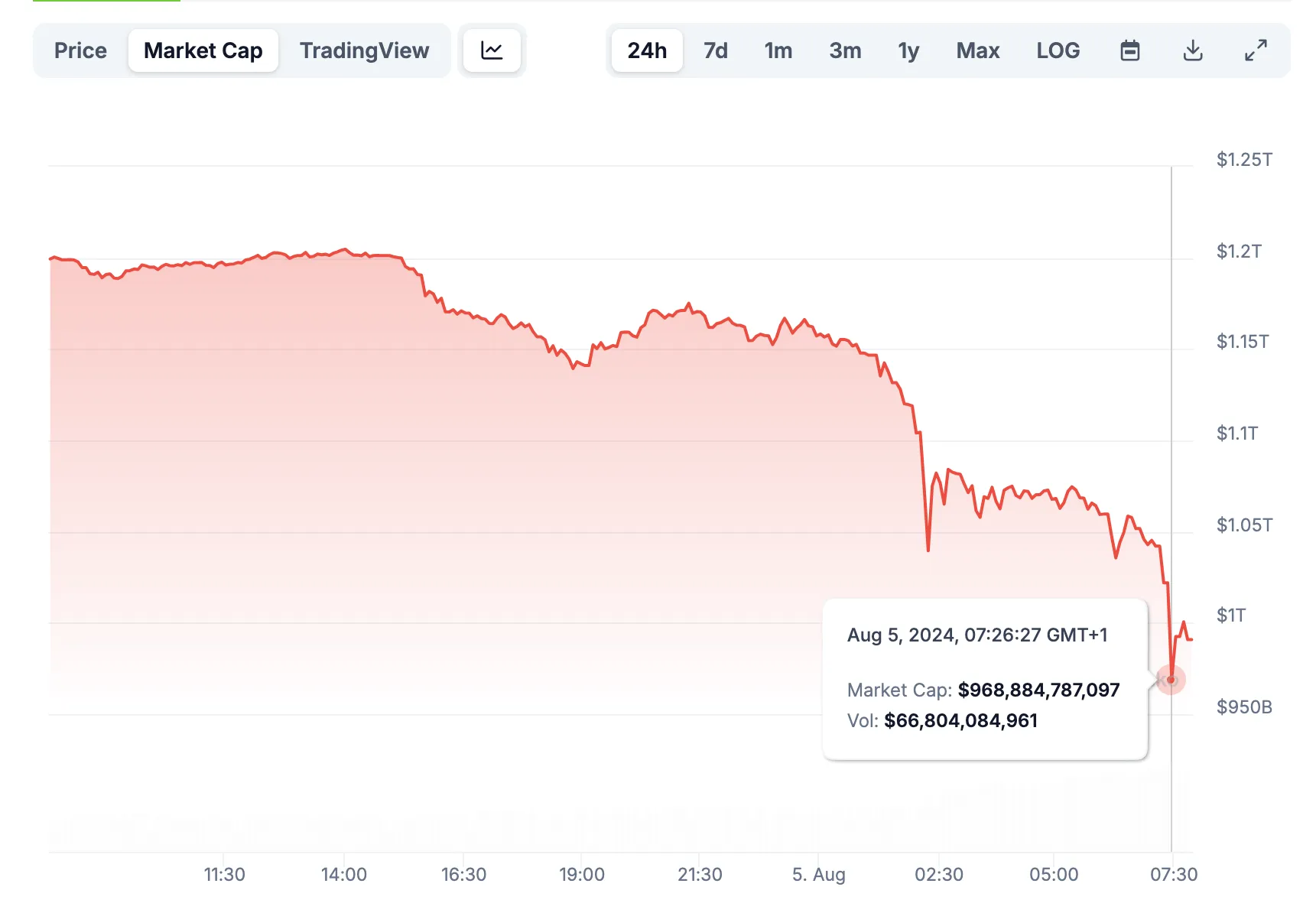
Following the development, different comments have spread around X, with some mentioning that the market could be heading into a bear phase.
For Whale Panda, this collapse has been one of the most brutal ones in a long time.
“BTC went from $70k to $52k in a week (-26%). ETH went from $3400 to $2100 (-39%). This has been one of the most brutal performances in a long time.” The pseudonymous Bitcoin holder wrote on X.
BTC Price Prediction: Down, But Not Out
Meanwhile, at press time, BTC had returned above $50,000. Specifically, the coin trades at $51,313. The bounce could be attributed to the Relative Strength Index (RSI) being in the oversold territory.
The RSI measures momentum, and also spots overbought and oversold levels. Readings above 80.00 indicate that a coin is overbought and could lead to a downward reversal. However, a rating below 30.00, as in Bitcoin’s case, indicates an oversold point, propelling the bullish reversal.
Read More: Bitcoin (BTC) Price Prediction 2024/2025/2030
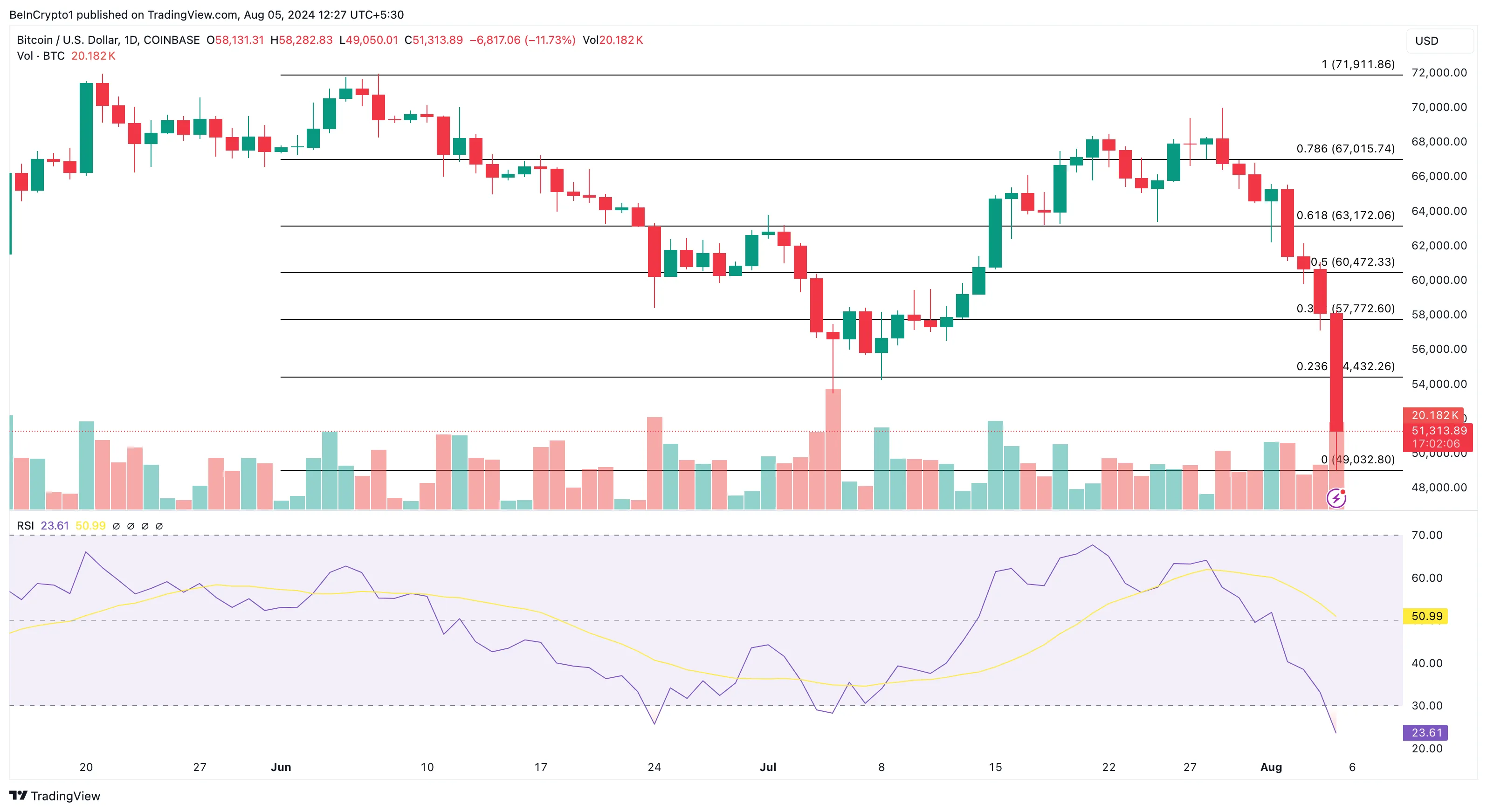
However, if the rebound continues, it could retest $54,423. If bulls are unable to sustain the hike, the coin’s price may fall back to $49,032.
Disclaimer
In line with the Trust Project guidelines, this price analysis article is for informational purposes only and should not be considered financial or investment advice. BeInCrypto is committed to accurate, unbiased reporting, but market conditions are subject to change without notice. Always conduct your own research and consult with a professional before making any financial decisions. Please note that our Terms and Conditions, Privacy Policy, and Disclaimers have been updated.
Bitcoin
Bitcoin to $250K? Hayes Links Price Surge to Fed’s QE Move

Arthur Hayes, former CEO of BitMEX, has predicted that Bitcoin (BTC) could soar to $250,000 by the end of the year.
However, this prediction is contingent on the US Federal Reserve (Fed) shifting its monetary policy toward Quantitative Easing (QE).
Bitcoin to $250,000, Hayes Predicts
Hayes argues that a halt in Quantitative Tightening (QT) and a return to liquidity injections would trigger a substantial Bitcoin rally.
“If my analysis regarding the interplay of the Fed, Treasury, and banking system is correct, then Bitcoin hit a local low of $76,500 last month, and now we begin the ascent to $250,000 by year-end,” read an excerpt in his latest blog.
This prediction hinges on his belief that central banks, particularly the Fed, will be forced to intervene to support financial markets, ultimately driving Bitcoin higher.
Further, the BitMEX co-founder directly ties Bitcoin’s potential price movement to the Fed’s approach to monetary policy. He argues that the central bank’s response to mounting fiscal pressures will lead to an end of QT and a de facto return to QE.
“Powell proved last week that fiscal dominance is alive and well and that he will do whatever it takes to ensure the Treasury can fund itself at reasonable rates. Therefore, I am confident QT, at least regarding treasuries, will stop in the short to medium term,” Hayes added.
Based on these, Arthur Hayes sees this as a pivotal moment for Bitcoin, emphasizing that the pioneer crypto would “scream higher once this is formally announced.”
Hayes also reinforced his confidence in the prediction, stating that his Bitcoin target is attainable as the bond market, banks, and Congress (which he terms BBC) will pressure the Fed into action.
British financial expert Raoul Pal supports the thesis of a bullish outlook for Bitcoin price. The former Goldman Sachs executive pointed to macroeconomic indicators that suggest a Bitcoin rally is imminent.
Raoul Pal shared a chart correlating the global M2 money supply and Bitcoin’s price. Based on history, Bitcoin tends to rise around 10 weeks after M2 increases, with Pal’s analysis suggesting that Bitcoin may soon enter a bullish phase.
“The waiting game is almost over…the 10-week lead is my preferred… but,” Pal remarked.
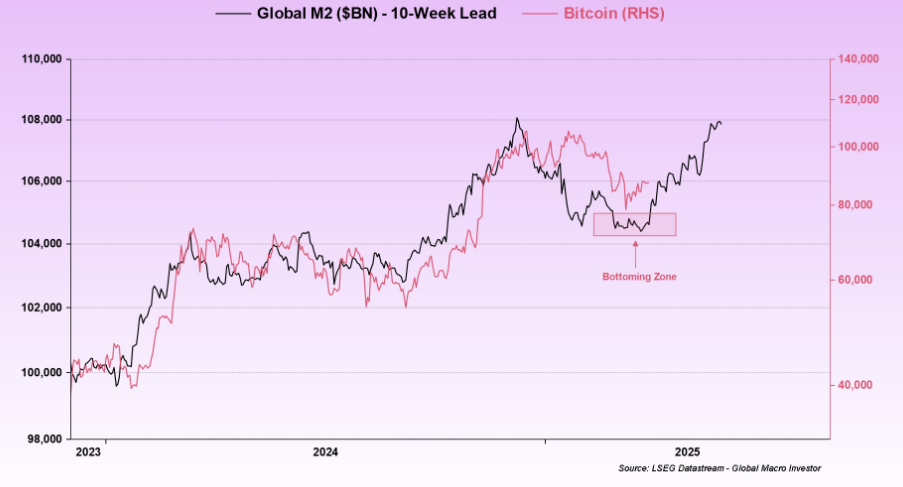
QCP Capital’s Stagflation Warning
Adding another layer to the macroeconomic picture, analysts at QCP Capital warn that if stagflation takes hold, the Fed could lean toward hiking rates instead of cutting them. Such an action would complicate the bullish outlook for Bitcoin.
“Markets continue to price 2.5 cuts in 2025. The Fed finds itself in a tight corner with consumer confidence and soft data coming in weak which may portend weaker GDP in Q2. At the same time, tariff-induced inflationary pressures could start building after April 2,” the analyst wrote.
The optimism comes despite Bitcoin logging its worst first quarter (Q1) performance in seven years. This notwithstanding, analysts point to a bullish momentum, suggesting that a price recovery is on the horizon.
“Sellers have dried up, and buyers seem comfortable with current price levels – setting the stage for a structural supply shortage. April-May could turn into a consolidation zone – a calm before the next impulse,” stated market analyst Axel Adler Jr.
Veteran investors are also increasing their Bitcoin holdings, signaling a phase of accumulation that often precedes strong price rallies. Market data also indicates that declining selling pressure from Bitcoin holders is paving the way for a potential push toward $90,000.
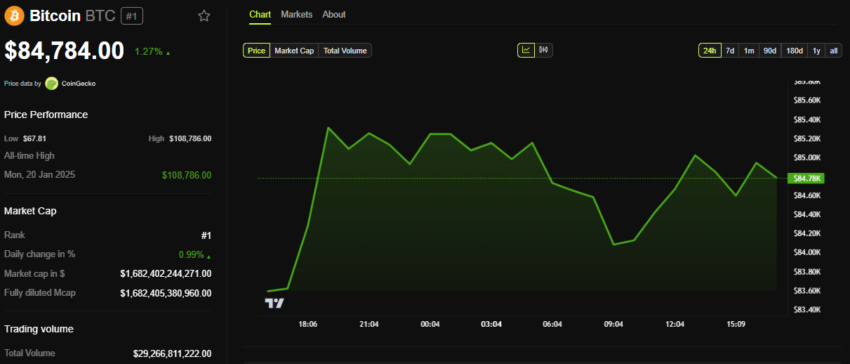
Meanwhile, Standard Chartered has noted Bitcoin’s growing role as an inflation hedge. This further solidifies the pioneer crypto’s place as a macroeconomic asset in uncertain financial times.
Nevertheless, as macroeconomic concerns continue challenging Bitcoin’s attractiveness, Gold is progressively presenting as an alternative store of value. BeInCrypto also reported that gold is outshining Bitcoin as a haven amid Trump’s 2025 tariff chaos.
Disclaimer
In adherence to the Trust Project guidelines, BeInCrypto is committed to unbiased, transparent reporting. This news article aims to provide accurate, timely information. However, readers are advised to verify facts independently and consult with a professional before making any decisions based on this content. Please note that our Terms and Conditions, Privacy Policy, and Disclaimers have been updated.
Bitcoin
US Dollar Index Drops – What Does It Mean for Bitcoin?

Amid the recent implementation of President Trump’s “Liberation Day” policies, the US Dollar Index (DXY) has plummeted to its lowest level since mid-October 2024. This signaled a turbulent time for the greenback.
Despite the downturn, some analysts believe the weakening dollar could fuel short-term gains for Bitcoin (BTC).
Could Bitcoin Benefit From a Weaker Dollar?
The DXY, a key measure of the US dollar’s strength against a basket of major currencies, has been under pressure amid a combination of factors. Growing concerns over a potential recession and escalating global trade tensions have contributed to this downtrend.
After reaching a two-year high in early January, the DXY has experienced a steady decline. Furthermore, it has shed nearly 4% in the first quarter alone.
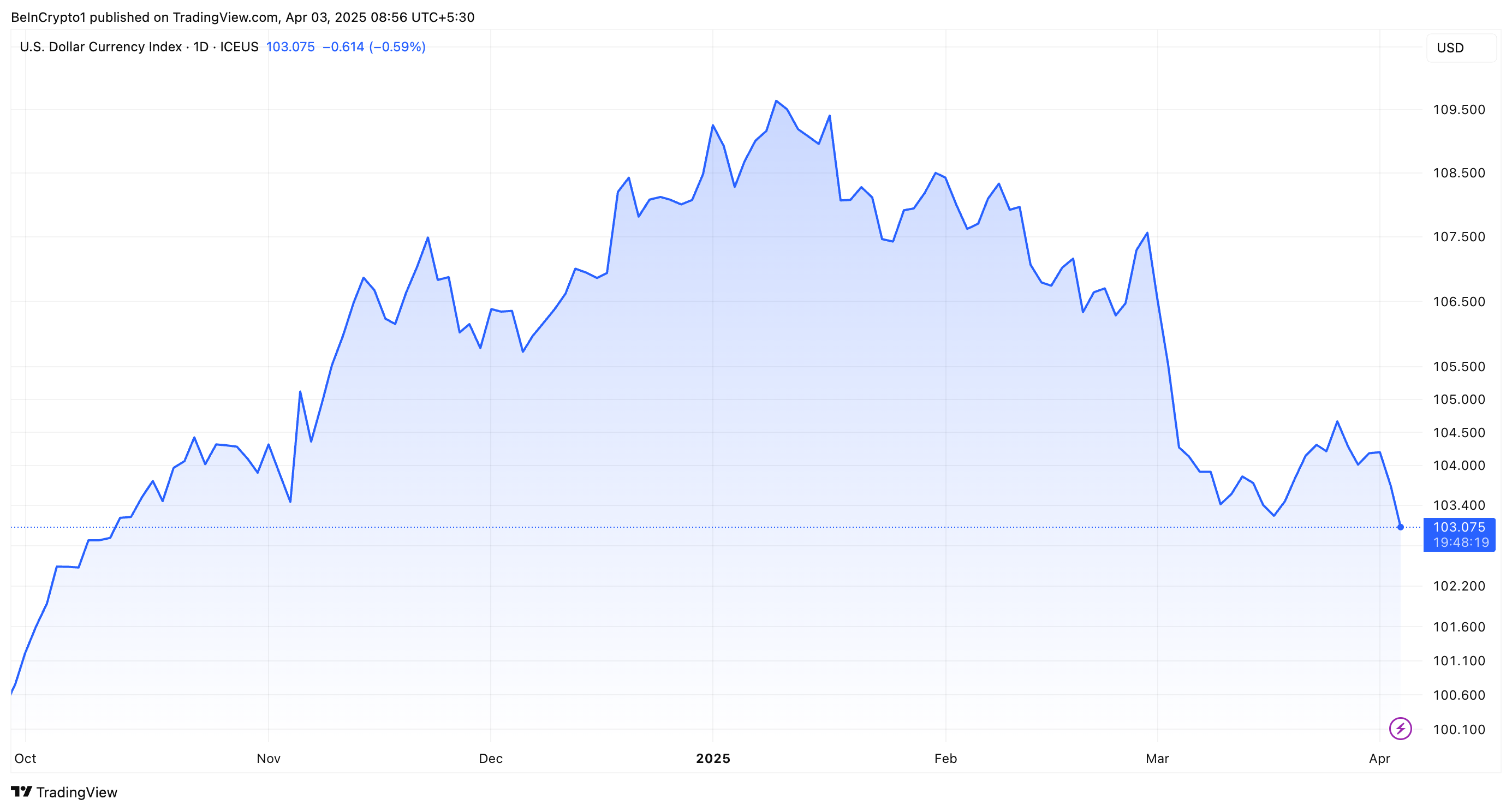
Economist Peter Schiff highlighted the dire state of the DXY in the latest X (formerly Twitter) post.
“The US Dollar Index has fallen to its lowest level since Oct. and looks like it’s headed much lower,” he wrote.
Schiff emphasized that contrary to expectations that a strong US dollar might alleviate the impact of tariffs on American consumers, the reality of a weakening dollar will have the opposite effect. Therefore, this exacerbates the financial strain from tariffs, making them more burdensome for consumers.
BeInCrypto reported that on April 2, 2025, President Trump implemented the new “Liberation Day” tariffs. These reciprocal tariffs enforce a minimum 10% duty on all imports. Nonetheless, they have raised concerns about a potential global trade war and further weakened the dollar’s value.
A Reuters report highlighted that the dollar slid against the yen. Meanwhile, the euro gained 0.3% to trade at $1.08, reflecting market unease over the tariff announcement.
However, it’s not all bad news—at least not for crypto. Some market observers believe Bitcoin could emerge as a key beneficiary of the dollar’s woes.
Ciara Sun, Founder and Managing Partner at C² Ventures noted on X that the likelihood of multiple Federal Reserve rate cuts in 2025 is growing. This move could further weaken the DXY and boost Bitcoin’s attractiveness.
“The Dollar Index shows signs of slowing momentum, potentially favoring risk assets,” Sun remarked.
Sun’s analysis aligns with the inverse correlation between Bitcoin and the US dollar, as outlined in a CoinGecko report from late 2024.
“When the dollar weakens, Bitcoin often strengthens, making it an attractive alternative,” the report noted.

Adding to the bullish sentiment for Bitcoin, Arthur Hayes, the former CEO of BitMEX, predicted a significant rally for the cryptocurrency.
“If BTC can hold $76,500 between now and US tax day April 15, then we are out of the woods. Don’t get chopped up!,” Hayes claimed.
This statement follows the executive’s prediction that Bitcoin could soar to $250,000 by year-end. However, this outcome is contingent upon the Federal Reserve adopting Quantitative Easing (QE) to support the markets.
Still, the road ahead is far from clear. Bitcoin may enjoy short-term gains amid the dollar’s slump. Yet, the overarching economic implications of shifting US monetary policy and ongoing global tensions continue to pose significant risks.

As of now, Bitcoin has felt the impact of the market uncertainty. It declined 1.5% in the past day to a trading value of $83,389. Similarly, the broader cryptocurrency marked has experienced a decrease, with the total market capitalization falling 3.4% within the same timeframe.
Disclaimer
In adherence to the Trust Project guidelines, BeInCrypto is committed to unbiased, transparent reporting. This news article aims to provide accurate, timely information. However, readers are advised to verify facts independently and consult with a professional before making any decisions based on this content. Please note that our Terms and Conditions, Privacy Policy, and Disclaimers have been updated.
Bitcoin
Lummis Confirms Treasury Probes Direct Buys


In an interview with Bitcoin commentator Natalie Brunell, Senator Cynthia Lummis (R-WY) reaffirmed her commitment to establishing a US Strategic Bitcoin Reserve (SBR), disclosing that the Treasury Department is probing its legal authority to purchase and custody BTC on behalf of the federal government. The senator believes such a move could significantly reduce the national debt over the long term.
Senator Lummis Pushes Bitcoin Reserve
Lummis pointed to roughly 200,000 BTC in the US Marshals Service’s asset forfeiture program as a possible starting point: “Working with Treasury, and the Treasury Secretary, we’re trying to find out which assets among those could become the basis of the first year’s investment in a strategic Bitcoin reserve.”
Further clarifying her stance, the senator noted she is determining whether a new law is required or if the administration already has the authority: “What I’m trying to figure out right now is whether it needs to be done legislatively or whether the Treasury Secretary has the authority to do it right now.”
Lummis proposes converting the seized BTC into an official “base investment,” which she says would be the foundation of a larger BTC reserve. If successful, this would mark the first time the US government deliberately and openly accumulated Bitcoin as a strategic asset.
One of Lummis’ main arguments for a SBR is its capacity to trim the federal debt, which she deems “irresponsibly high.” Under her Bitcoin Act, the US could also revalue its gold certificates—currently listed at a decades-old official price of $42 per ounce, far below market value—and deploy the difference toward purchasing BTC in a budget neutral way:
“My legislation would provide that we could take our gold certificates… bring them up to current fair market value for gold and then use that to buy Bitcoin, thereby creating a 1 million Bitcoin reserve over five years.”
She contends that holding this million BTC over a 20-year horizon could “cut the current national debt in half.” Citing extensive modeling—some from advocates like Michael Saylor—she believes the price appreciation of BTC has the potential to deliver significant gains to taxpayers.
New Episode Out Now! 🇺🇸
U.S. Senator Cynthia Lummis is leading the Bitcoin Revolution in Washington.
Her bold plans for America through Bitcoin & digital asset policy promise to reshape the financial system—reduce U.S. debt, protect Bitcoin self-custody, and reinforce dollar… pic.twitter.com/G1Rvl1ORDb
— Natalie Brunell ⚡️ (@natbrunell) April 1, 2025
The senator lauded President Trump’s recent executive orders that aim to make the United States “the digital asset capital of the world” by fostering a favorable environment for BTC mining, regulatory clarity, and a strategic reserve. According to Lummis, those moves stand in stark contrast to prior administrations, where “people neither knew nor wanted to talk about digital assets.”
However, Lummis also underscored the need for bipartisan collaboration, suggesting that while Bitcoin has now garnered interest in Republican circles, it should not become a strictly partisan endeavor: “We want to keep that momentum… We worked extremely hard to keep it bipartisan, so I can’t flip my brain and start to think of it as a partisan issue.”
At press time, BTC traded at $84,202.

Featured image from YouTube, chart from TradingView.com

Editorial Process for bitcoinist is centered on delivering thoroughly researched, accurate, and unbiased content. We uphold strict sourcing standards, and each page undergoes diligent review by our team of top technology experts and seasoned editors. This process ensures the integrity, relevance, and value of our content for our readers.
-

 Regulation19 hours ago
Regulation19 hours agoKraken Obtains Restricted Dealer Registration in Canada
-

 Altcoin23 hours ago
Altcoin23 hours agoWhat’s Fueling The Shibarium Boost?
-

 Bitcoin20 hours ago
Bitcoin20 hours agoLummis Confirms Treasury Probes Direct Buys
-

 Altcoin15 hours ago
Altcoin15 hours agoHere’s Why This Analyst Believes XRP Price Could Surge 44x
-

 Altcoin11 hours ago
Altcoin11 hours agoFirst Digital Trust Denies Justin Sun’s Allegations, Claims Full Solvency
-

 Altcoin21 hours ago
Altcoin21 hours agoFranklin Templeton Eyes Crypto ETP Launch In Europe After BlackRock & 21Shares
-

 Altcoin14 hours ago
Altcoin14 hours agoHow Will Elon Musk Leaving DOGE Impact Dogecoin Price?
-

 Ethereum13 hours ago
Ethereum13 hours agoWhy A Massive Drop To $1,400 Could Rock The Underperformer




















